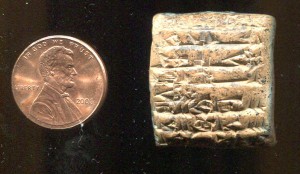 After 3 years of looking, I have finally acquired a 4,000-year-old Sumerian cuneiform tablet! This clay tablet was written in Mesopotamia (current-day Iraq), dates from 2230-2221 BCE, and is a receipt (as many of these documents are) for twenty bundles of sheepskin hides for garments, with a seal of the royal scribe and the date. It originated from Umma at the city-state of Ur.
After 3 years of looking, I have finally acquired a 4,000-year-old Sumerian cuneiform tablet! This clay tablet was written in Mesopotamia (current-day Iraq), dates from 2230-2221 BCE, and is a receipt (as many of these documents are) for twenty bundles of sheepskin hides for garments, with a seal of the royal scribe and the date. It originated from Umma at the city-state of Ur.
The period of the Third Dynasty of the city-state of Ur was one of the most brilliant periods of Mesopotamian history. What we know of the workings of the government and the economy are derived from these documents. Dated the sixth month of the eighth year of Bur Sin, King of Ur. With a fine seal impression which reads “on the authority of the Royal scribe, Ursulpe, son of Lugulsaga.” The balance of the information on this tablet has not been translated.
PROVENANCE (history of ownership): Apparently one of the many artifacts excavated by Hormuzd Rassam (1826-1910), the famous discoverer of the Epic of Gilgamesh, and given in 1895 with a group of other tablets to Theophilus G. Pinches, LL.D. (1856-1934), an eminent Assyriologist at the British Museum. Pinches described some of these tablets in The Amherst Tablets (1908). The tablets passed to a student and colleague of Pinches named Chappelow in the 1920s, and after the latter’s death, went to Sotheby’s (London) for auction. The Sotheby catalog was prepared by Dr. R. D. Barnett of the Dept. of Western Asiatic Antiquities at the British Museum and the tablets sold on July 28, 1958 to Dr. Herman Serota of Chicago. In 1978 Dr. Serota sent the tablets to the Oriental Institute at the University of Chicago where they were transliterated by Dr. Piotr Steinkeller (of Yale). Dr. I. J. Gelb also examined the tablets and provided some translations. Serota died in 1981, whereupon the record ends–most likely the tablets entered the trade and were dispersed, possibly moving through private hands occasionally. The Boston dealer from whom we purchased this tablet bought it from a California dealer in February–but we trust it has arrived at its final destination!
It is a tiny artifact, shown here with a penny for scale. In terms of book and writing history, these tablets are so important to be able to show as one of the oldest extant examples of writing.